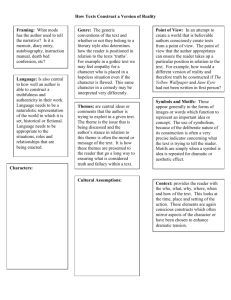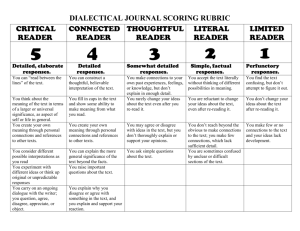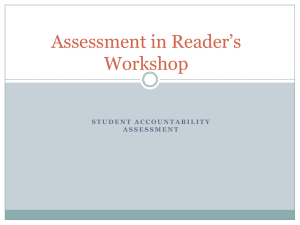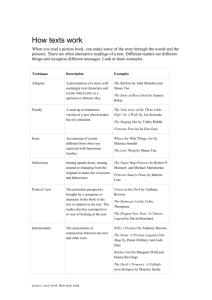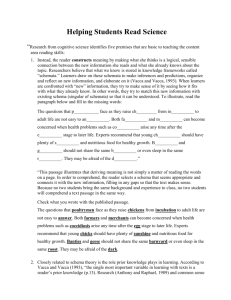The Active Reader - School of Journalism and Communication
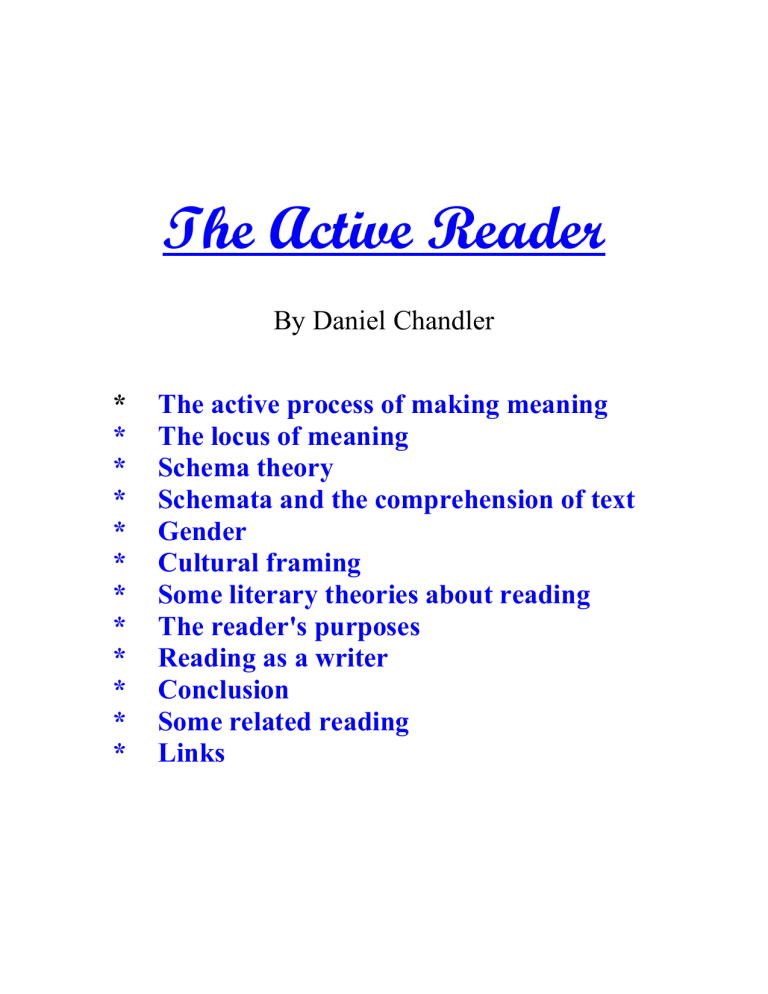
The Active Reader
By Daniel Chandler
* The active process of making meaning
* The locus of meaning
* Schema theory
* Schemata and the comprehension of text
* Gender
* Cultural framing
* Some literary theories about reading
* The reader's purposes
* Reading as a writer
* Conclusion
* Some related reading
* Links
The active process of making meaning
In the context of a culture in which it is generally assumed that information can be 'retrieved' from books or computers I suggest that there is no
'information' in them.
The interpretive perspective which makes most sense to me is that human beings make meanings by a dynamic process of interpretation rather than by passive assimilation.
There are various theories of how perception works, and there are no purely objective 'findings' which can settle the matter: all such 'findings' are framed by theoretical assumptions.
As Roszak notes, 'every fact grows from an idea; it is the answer to a question we could not ask in the first place if an idea had not been invented which isolated some portion of the world, made it important, focused our attention, and stimulated inquiry' (Roszak 1986, p. 105).
Those whose epistemological assumptions veer towards 'realism' tend to emphasize a passive reception of sensory data from an external world. Those who veer towards epistemological idealism emphasize a subjective act of mental construction.
The locus of meaning
The range of theories about where meaning emerges in the relationship between readers and texts can be illustrated as a continuum between two extreme positions (see Figure 1).
----------------------------------------------------------------
--
Objectivist Constructivist Subjectivist meaning meaning meaning entirely -----------in interplay --------entirely in its in text between text interpretation
and reader by readers
'transmitted' 'negotiated' 're-created'
-------------------> reader as less 'passive', more 'active'
----------------------------------------------------------------
--
Figure 1: Locus of Meaning in the Reading of Texts
A text cannot speak for itself: it needs a reader as well as a writer.
Research work in cognitive psychology and psycholinguistics emphasizes the creative activity of the reader. The psycholinguist Kenneth Goodman (1976) argued that the meaning of a text depends on what the reader brings to it. And Frank Smith's books on reading have stressed that at all levels reading involves active interpretation (see Smith 1978).
Schema theory
In reading as in all visual perception the eye is selective. Look at this block of text:
Q Q Q Q Q Q Q
Q Q Q Q P Q Q
Q Q O Q Q Q Q
Q Q Q Q Q Q Q
Q Q Q Q Q Q Q
Most people notice the letter 'P' almost immediately. But some readers don't notice the 'O'. This is a simple but powerful illustration of the selectivity of vision: we usually tend to see what the general context suggests as most likely to be present. We rely a great deal on such expectations to guide our reading.
In the act of reading the eye of the experienced reader does not simply start at the beginning of the text and proceed from word to word until it reaches the end (see separate illustration). It jumps around the page as the mind searches for organizing patterns which make the task of reading easier. We are forever drawing on our past experiences to guide the ways in which we interpret our present experiences.
The word schema (plural: schemata or schemas) is used by cognitive psychologists to refer to a kind of mental template (also called a 'cognitive structure' or a 'knowledge structure'). Schemata are stored in long-term memory and are employed when we interpret our experiences.
Schemata and the comprehension of text
Reading is not the passive assimilation of textual information.
Comprehension requires the reader to go, in
Jerome Bruner's phrase, 'beyond the information given'.
Even the most mundane texts require the reader to go beyond that which is explicitly stated in order to make sense of them, though we are normally unaware of the extent of such interpretation in our everyday reading.
Texts are full of 'indeterminacies' which require the reader's active interpretation. We must draw not only on our knowledge of language but on our knowledge of the world.
In an example from Sir Frederic Bartlett (see separate illustration) if we see at a distance a painted notice next to a farm gate on the public highway unconscious recognition of the length and number of the words may be enough for us to infer that it is most likely to say 'TRESPASSERS WILL BE
PROSECUTED': we may not need to see the words clearly at all. Hence the common trick of people protecting their parking areas with the sign,
POLITE NOTICE - NO PARKING
, which if painted in tidy imitation of official white on blue may deceive other drivers into assuming that it is a more official POLICE 'No Parking' notice. We draw on such assumptions all the time in making rapid sense of texts.
Whenever we read we draw widely on our knowledge of the world. Even with adequate English vocabulary and grammar, think what sense an interplanetary visitor to Earth might make of a sign such as
'Dogs must be carried on the escalator'.
“To understand this notice I need to do a great deal more than simply read its words one after the other. I need to know, for example, that these words belong to what might be called a 'code of reference' - that the sign is not just a decorative piece of language there to entertain travelers, but is to be taken as referring to the behavior of actual dogs and passengers on actual escalators. I must mobilize my general social knowledge to recognize that the sign has been placed there by the authorities, that these authorities have the power to penalize offenders, that I as a member of the public am being implicitly addressed, none of which is evident in the words themselves. I have to rely, in other words, upon certain social codes and contexts to understand the notice properly. But I also need to bring these into interaction with certain codes or conventions of reading - conventions which tell me that by 'the escalator' is meant this escalator and not one in Paraguay, that 'must be carried' means 'must be carried now', and so on. I must recognize that the
'genre' of the sign is such as to make it highly improbable that... [certain ambiguities are] actually intended [such as that you must carry a dog on the escalator]... I understand the notice, then, by interpreting it in terms of certain codes which seem appropriate.
(Eagleton 1983, p. 78)
You may come across references to what are called
'story grammars'.
Strictly speaking, these are formal rule systems for describing the regularities found in one kind of text
(Mandler 1984, p. 18).
More to our purpose are story schemata or story schemes: mental structures consisting of 'sets of expectations about the way in which stories proceed'
(p. 18).
Story schemata reflect the story grammars we discover or construct. Generic discourse structures for stories involve typical plots (including beginnings, episodes and endings), characters, settings and so on.
We are all aware of schemata for various genres in everyday documents, literature, TV and film. As experienced adults, we can easily recognize the general formats of fairy tales, thrillers, detective stories, TV news programmes, recipes and so on.
It would appear that through repeated exposure to stories of various general types we internalize idealized schemata for them, making it easier for us to comprehend them, to represent them in memory and to recall them. For instance, stories told in the order we normally expect are recalled more easily than those which flout these expectations.
Comprehension and memory are poor in the absence of an appropriate schema. Try this sentence:
'the notes were sour because the seams were split'.
The words and the syntax are simple, but the sentence usually confuses people until they realize, or are told, that the context involves 'bagpipes'!
According to schema theory, this clue triggers the activation of a schema which allows us to interpret the sentence more successfully. So too with this one:
'The haystack was important because the cloth ripped', which refers to a parachutist.
Gender
Readers draw upon different repertoires of schemata, partly as a result of their cultural background, experience, knowledge and social roles.
Read this short passage:
A big Indian and a little Indian are sitting on a log. The big Indian points to the little Indian and says, 'That Indian is my son.' The little Indian points to the big
Indian and says, 'That Indian is not my father.' Both are telling the truth. How is this possible?
Crawford and Chaffin argue that 'the standard, male viewpoint on an experience might be viewed as a very high-level schema or set of schemata.
Because the male viewpoint is diffuse and pervasive, neither men nor women can readily step in and out of it as they attempt to apprehend their experiences.
To discard it entirely would require an alternative schema such as a woman's viewpoint.
But alternative viewpoints... are less well articulated, or they may not exist' (p. 25).
When a passage is ambiguous, comprehension and memory are guided by the schema which is more readily invoked. The ease of activating particular schemata can be partly related to some of the reader's roles in society.
Cultural framing
In some early experiments, Sir Frederic Bartlett (1932) showed how readers employed schemata to interpret stories from an unfamiliar culture in a manner which made more sense to them. For recall, they drew upon these schemata to reconstruct the story. This resulted in a considerable amount of unconscious distortion and elaboration of the original.
Richard Anderson notes that the schemata which are brought to bear on texts are culturally shaped, and can be related to the reader's age, sex, race, religion, nationality and occupation (in Singer & Ruddell 1985, pp. 374-5).
He offers findings from a cross-cultural experiment in which Americans and natives of India read letters about an Indian and an American wedding. The table below summarizes their recall of the letters:
------------------------------------------------------
MEASURE AMERICANS INDIANS
American Indian Indian American
passage passage passage passage
------------------------------------------------------
Time (secs) 168 213 276 304
Gist recall 52.4 37.9 37.6 27.3
Elaborations 5.7 0.1 5.4 0.2
Distortion 0.1 7.6 0.3 5.5
Other errors 7.5 5.2 5.9 8.0
Omissions 76.2 76.6 83.3 95.5
------------------------------------------------------
Mean Performance on Various Measures
(From Anderson, in Singer & Ruddell 1985, p. 378).
'Gist recall' refers to the number of idea units recalled. 'Elaborations' refers to the frequency of culturally appropriate extensions of the text. 'Distortions' refers to the frequency of culturally inappropriate modifications of the text.
Clearly, readers spent less time reading what was for them the native passage (this is consistent with familiar schema speeding up
comprehension). As expected, Americans recalled more of the American passage and Indians recalled more of the Indian passage. Anderson comments that 'a culturally appropriate schema may provide the ideational scaffolding that makes it easy to learn information that fits into that schema, or, it may be that the information, once learned, is more accessible because the schema is a structure that makes it easy to search memory' (p. 378).
Part of the American passage was as follows:
Did you know that Pam was going to wear her grandmother's wedding dress? That gave her something that was old, and borrowed, too. It was made of lace over satin, with very large puff sleeves and looked absolutely charming on her.
If we remember that accuracy of recall was intended, it is fascinating to note the unconscious distortions that such sentences gave rise to when read by those for whom aspects of the passage were culturally strange.
Without intentional distortion, one Indian reader commented:
'She was looking all right except the dress was too old and out of fashion'.
This involved an inference which was culturally appropriate in the context of
Indian marriages, where an up-to-date sari would be important, but inappropriate for the cultural context of the passage, where the dress was an heirloom. Similarly, the Indian passage presented difficulties for the
American readers, who reinterpreted the reference to 'gifts to be given to the in-laws' as a two-way 'exchange of gifts'.
Other groups of Indians and Americans were asked to rate the importance of different elements in the passages. Americans regarded as important elements concerning ritual and ceremony and Indians saw as more important those concerning financial and social status. Anderson comments that
'schema theory predicts that text units that are important in the light of the schema are more likely to be learned, and, once learned, are more likely to be remembered. This prediction was confirmed. Subjects did recall more text information rated as important by their cultural cohorts, whether recalling what for them was the native or the foreign text' (Anderson in
Singer & Ruddell 1985, p. 379).
Some literary theories about reading
Most people would acknowledge that interpretation is important in the arts.
In the field of literary criticism and theory, the study of the act of reading tends to be referred to as 'reader- response criticism', 'reception theory' or
'audience-oriented criticism' in contrast to 'text- centred theories'. Whilst there are still some literary critics who claim that meaning depends upon
'authorial intention', and 'formalists' who insist that meaning resides 'in' the text itself, many modern literary critics emphasize the importance of the reader, the act of reading, and the reader's interpretation of the meaning of the text. Reception theorists have emphasized the dynamic nature of interpretation by the reader. We often revise some of our assumptions as we read more of the same text (see Eagleton 1983, pp. 76ff). Reader-oriented literary theorists include phenomenologists, psychoanalytical subjectivists, and socio-historical critics.
Phenomenological theorists of the act of reading are concerned with the experience whereby individual readers 'realize' a text. 'The act of reading is defined as essentially a sense-making activity, consisting of the complementary activities of selection and organization, anticipation and retrospection, the formulation and modification of expectations in the course of the reading process. Although every reader performs these activities, exactly how they are performed varies from reader to reader and even within a single reader at different times; these variations account for different realizations of a given text... Variations in the readings of a text are thus attributable to variations in the activities of selection and organization...
There is a wide spectrum of acceptable realizations for any one text'
(Suleiman 1980, pp. 22-3). The most well-known phenomenological theorist of reading is Wolfgang Iser, whose primary concern is with the reading of literary texts. He argues that all texts have 'gaps', or elements of textual indeterminacy, which readers have exercise creativity to bridge. But for Iser the text is ultimately dominant: textual features strongly constrain the reader's interpretation. One problems with phenomenological critics is that they have tended to generalize 'the reader' and 'the reading experience'.
Psychoanalytic critics such as Norman Holland are more interested in the role of the reader's personality and personal history in the interpretation of texts. For Holland the reader rather than the text is in control: the reader
'recreates' the text. He studied in an experimental way how interpretation by individual readers varied according to their own personalities. But such approaches have been criticized for as over-dependent on the researcher's own interpretation and for reifying the notion of an enduring and autonomous 'self'. Subjectivist critics interpret reading as a private experience rather than as socially shaped.
Structuralists reject both the idea of intrinsic textual meaning and the idea of individuals as the makers of meaning. And socio-historical critics interpret reading more sociologically, seeing reading as more social, and readers as part of a historically-specific 'reading public'. They tend not to foreground the act of reading, but emphasize that although reading usually takes place in solitude, it is nevertheless a social activity framed by social conventions. In 1980 the American literary theorist Stanley Fish wrote an influential book, Is There A Text In This Class? Fish is not strongly sociallyoriented, since the reader and the act of reading is his central concern, but he did introduce some concepts which make allowance for the social framing of reading. And whilst rejecting the objectivity of the text he insisted that he rejected pure subjectivism (Fish 1980, p. 11).
Whilst arguing for the fundamental importance of readers' interpretations of texts, he has also limited the possible range of reader's meanings by stressing the importance of 'interpretive communities', defined by the nature of their responses to texts. He declares that 'The reader is... not... a free agent... but... a member of a commmunity whose assumptions about literature determine the kind of attention he pays... The act of recognizing literature... proceeds from a collective decision as to what will count as literature' (p. 11). At least in academia, literary scholars cannot avoid being aware of the existence of various critics, biographies, similar and dissimilar texts by the same author and others, differing schools of thought about the author or about criticism and so on. Fish has also referred to the importance of reading strategies, which are socio-historical conventions shared by interpretive communities.
But Fish does not investigate the sociological and political implications of such notions (see Eagleton 1983, p. 89). Marxists in particular insist on the importance of ideology and class.
I should add that we cannot suggest, like Lewis
Carroll's Humpty Dumpty, that words mean whatever what we want them to mean. Language is a social contract based on a broad agreement about what words mean. Meanings emerge in specific socio-historical contexts, and we can no more ignore that of the author than that of the reader.
If we were to do so, what would we make of lines such as Wordsworth's
'Heavens look down on this poor sod'? Is it perhaps, someone's prayer for divine forgiveness for his sexual practices (see Robert Sharple in McGregor
& White 1990, p. 191)?
Degrees of textual openness
Of course, the extent to which the reader is involved in constructing meaning depends partly on the kind of text involved. Some texts are more
'open' than others. For instance, one would usually expect more active interpretation by the reader to be involved with a poem than with a telephone directory. David Olson has argued that in formal scientific and philosophical writing 'the meaning is in the text' rather than in its interpretation (Olson
1977: 277), but (whilst some may indeed see this as a goal), textual meanings can never be severed from interpretation.
In his widely-acclaimed book S/Z (1974), Roland Barthes refers to two kinds of writing in terms of the extent to which they involve the reader: the readerly ('lisible') and the writerly ('scriptible').
Texts of the readerly kind leave the reader 'with no more than the poor freedom either to accept or reject the text'
(cited in Hawkes, 1977: 114): they treat the writer as producer and the reader as submissive consumer and suggest their 'reflection' of 'the real world'.
Texts of the writerly kind invite the active participation of the reader, and also, in their attention to linguistic mediation, an involvement in the construction of reality. Ironically, it is readerly texts which tend to be described as
'readable', whilst writerly texts are often referred to as 'unreadable'.
Some theorists refer to texts normally having a
'preferred reading'
.
Texts which are less open have one reading which is most strongly preferred. More open texts invite a number of different kinds of readings.
Open texts tend to be associated by literary critics with highbrow culture, whereas 'closed' texts tend to be associated by such critics with popular, mass culture.
The sociologist Stuart Hall and colleagues
(Hall et al. 1980) argue (in the context of TV programmes) that there are three main kinds of readings:
dominant hegemonic, which accepts the preferred reading;
negotiated, which adapts the known preferred reading;
oppositional, which radically opposes the preferred reading.
The reader's purposes
Barthes' observations are useful, but I would also wish to stress that the degree of reader involvement depends not only on the type of text and on how readerly or writerly it is, but on how the text is used. Poetry is sometimes 'consulted' for biographical information and telephone directories have occasionally been used as sources of 'found poetry'. At least with experienced readers, how a text is used is almost entirely up to the reader.
Certainly, the reader's purposes are at least as important as the author's intentions. Whilst Swift's Gulliver’s Travels may have been primarily intended as a satire, this does not stop children enjoying it purely as entertainment. Spectacular examples of bureaucratic prose may lead not to enlightenment as intended by the writer but to hilarity. And most readers of an academic text are likely to use it primarily for their own purposes rather than to establish the author's 'intentions'. Coleridge reported that he read
Pilgrim’s Progress 'once as a theologian, once with devotional feelings... and once as a poet' (cited in Jackson 1946, p. 65). Our purposes are not static: we may return to a text and make quite different meanings with it on each occasion. Where we have left marginal glosses, we may sometimes wonder how we could possibly have been so intrigued by ideas which now seem insignificant. What you are reading now may be interpreted in any number of ways according to your own purposes.
Richard Anderson comments that 'Depending on the reader's goal, task or perspective, he or she may override the conventions a linguistic community ordinarily uses to structure a text'
(Anderson 1978, p. 74).
Reading as a writer
Conclusion
Richard Anderson insists that 'it should not be imagined that there is some simple, literal level of comprehension of stories and texts that does not require coming up with a schema.' He adds that schema theory sharply contrasts with 'the conventional view that comprehension consists of aggregating the meanings of words to form the meanings of clauses, aggregating the meanings of clauses to form the meanings of sentences, aggregating th meanings of sentences to form the meanings of paragraphs, and so on...
The meanings of the words cannot be "added up" to give the meaning of the whole. The click of comprehension occurs only when the reader evolves a schema that explains the whole message' (Anderson, in Singer & Ruddell 1985, pp. 373, 375).
Clearly, comprehension and memory are active rather than passive processes. The construction of meanings would appear to involve the use of schemata, which lead not only to alterations and distortions but also to understanding. For experienced readers reading is a continual process of making inferences, evaluating the validity and significance of texts, relating them to prior experience, knowledge and viewpoint, and considering implications. Schema theory suggests that reading is not passive 'information retrieval'. And I should add, referring to a phrase promoted by so many ignorant politicians and foolish educationalists in the UK at present, a curriculum cannot simply be 'delivered' like a postal package.
Some related reading
* Anderson, Richard C (1978): 'Schema-Directed Processes in
Language Comprehension'. In Alan M Lesgold, James W Pellegrino, Sipke
D Fokkema & Robert Glaser (Eds.): Cognitive Psychology and Instruction.
New York: Plenum Press
* Barthes, Roland (1974): S/Z (trans. Richard Miller). Oxford: Basil
Blackwell
* Bartlett, Frederic C (1932): Remembering. Cambridge: Cambridge
University Press
* Bransford, J D & M K Johnson (1972): 'Contextual prerequisites for understanding: some investigation of comprehension and recall', Journal Of
Verbal Learning And Verbal Behavior 11: 717-26
* Crosman, Robert (1980): 'Do Readers Make Meaning?'. In Suleiman
& Crosman, op. cit.
* Crowder, Robert G (1982): The Psychology Of Reading: An
Introduction. New York: Oxford University Press
* Deaux, Kay & Lawrence S Wrightsman (1988): Social Psychology.
Pacific Grove, CA: Brooks/Cole
* Eagleton, Terry (1983): Literary Theory: An Introduction. Oxford:
Basil Blackwell
* Ellis, Andrew & Geoffrey Beattie (1986): The Psychology Of
Language And Communication. Hillsdale, NJ: Lawrence Erlbaum
* Fish, Stanley (1980): Is There A Text In This Class? The Authority Of
Interpretive Communities. Cambridge, MA: Harvard University Press
* Flynn, Elizabeth A & Patrocinio P Schweickart (Eds.) (1986): Gender
And Reading: Essays On Readers, Texts And Contexts. Baltimore: Johns
Hopkins University Press
* Goodman, Kenneth (1976): 'Reading: A Psycholinguistic Guessing
Game'. In Nancy A Johnson (Ed.): Current Topics In Language. Cambridge,
MA: Winthrop
* Hall, Stuart, D Hobson, A Lowe & P Willis (Eds.) (1980): Culture,
Media, Language. London: Hutchinson
* Hawkes, Terence (1977): Structuralism And Semiotics. London:
Routledge
* Holland, Norman (1973): Poems In Persons: An Introduction To The
Psychoanalysis Of Literature. New York: Norton
* Iser, Wolfgang (1974): The Act Of Reading. London: Routledge &
Kegan Paul
* Jackson, Holbrook (1946): The Reading Of Books. London: Faber
* Kennedy, Alan (1984): The Psychology Of Reading. London:
Methuen
* Lindsay, Peter H & Donald A Norman (1977): Human Information
Processing: An Introduction To Psychology (2nd edn.). New York:
Academic Press
* Olson, David (1977): 'From utterance to text: The bias of language in speech and writing', Harvard Educational Review 47 (3): 257-81
* Mandler, Jean M (1984): Stories, Scripts And Scenes: Aspects Of
Schema Theory. Hillsdale, NJ: Lawrence Erlbaum
* McGregor, Graham & R S White (Eds.) (1990): Reception And
Response: Hearer Creativity And The Analysis Of Spoken And Written
Texts. London: Routledge
* Plimpton, George (Ed.) (1988): Writers At Work: The 'Paris Review'
Interviews. Harmondsworth: Penguin
* Robeck, Mildred C & Randall R Wallace (1990): The Psychology Of
Reading: An Interdisciplinary Approach. Hillsdale, NJ: Lawrence Erlbaum
* Roszak, Theodore (1986): The Cult Of Information: The Folklore Of
Computers And The True Art Of Thinking. Cambridge: Lutterworth Press
* Singer, Harry & Robert B Ruddell (Eds.) (1985): Theoretical Models
And Processes Of Reading (3rd edn.). Newark, DW: International Reading
Association/Lawrence Erlbaum
* Smith, Frank (1978): Reading. Cambridge: Cambridge University
Press
* Smith, Frank (1983): Essays Into Literacy. London: Heinemann
* Smith, Frank (1988): Understanding Reading. Hillsdale, NJ:
Lawrence Erlbaum
* Suleiman, Susan R (1980): 'Introduction: Varieties of Audience-
Oriented Criticism'. In Suleiman & Crosman, op. cit.
* Suleiman, Susan R & Inge Crosman (Eds.) (1980): The Reader In The
Text: Essays On Audience and Interpretation. Princeton, NJ: Princeton
University Press
Daniel Chandler, UWA December 1995


